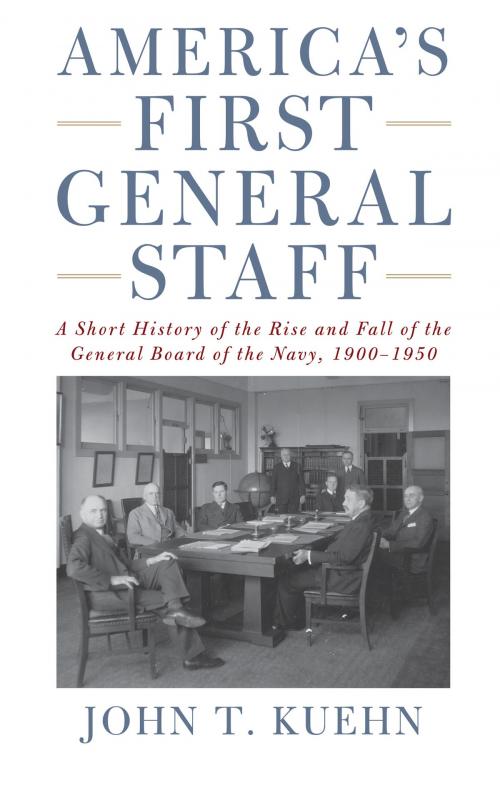America's First General Staff
A Short History of the Rise and Fall of the General Board of the U.S. Navy, 1900-1950
Nonfiction, History, Military, Naval| Author: | Kuehn | ISBN: | 9781682471920 |
| Publisher: | Naval Institute Press | Publication: | October 15, 2017 |
| Imprint: | Naval Institute Press | Language: | English |
| Author: | Kuehn |
| ISBN: | 9781682471920 |
| Publisher: | Naval Institute Press |
| Publication: | October 15, 2017 |
| Imprint: | Naval Institute Press |
| Language: | English |
The General Board of the Navy was a uniquely American strategic planning organization with few analogs at the time of its establishment, except perhaps the various components of the Admiralty in Great Britain. It existed from 1900 to 1950. Then, as now, confusion reigned over what sort of fleet to design and how to build it. The General Board served as the “balance wheel,” or nexus, for bringing together coherent strategy and fleet design. As John T. Kuehn shows, this Board was the United States’ first modern general staff in peacetime. It emerged from the trends and developments of the Progressive Era of the late 19th and early 20th centuries. Its creation was very much a reflection of the reformist spirit of the times that also gave birth to the Army War College, the Army General Staff, and the Chief of Naval Operations. As such it reflected a uniquely American attempt to reconcile the primacy of civilian control with the new requirements of the modern age that seemed to dictate a more formal military and naval planning establishment and associated processes and methods. Thus its name reflected corporate America as well as longstanding naval tradition to meet challenges and problems with special, temporary boards. The General Board, however, differed from these temporary boards due to its longevity. By the 1920s it had become a permanent feature of the Navy and was regarded as the premier strategic “think tank” for advice to the Secretary of the Navy. The author highlights how this small body wielded immense influence over its organizational life that was, on balance, innovative, progressive, and productive for the security of the United States in peace and its success in war via the mechanism of its Navy. The service of the men who comprised it is little-known, but their collaborative and creative ethos should still serve as a model for the modern analogs of today like strategic initiatives groups (SIGs). Kuehn’s organizational history of this body reflects the turbulence of those times as well as provides a not too “distant mirror” to understand a complexities involved in building a Navy that saw the transition from coal and sail to the nuclear powered warships.
The General Board of the Navy was a uniquely American strategic planning organization with few analogs at the time of its establishment, except perhaps the various components of the Admiralty in Great Britain. It existed from 1900 to 1950. Then, as now, confusion reigned over what sort of fleet to design and how to build it. The General Board served as the “balance wheel,” or nexus, for bringing together coherent strategy and fleet design. As John T. Kuehn shows, this Board was the United States’ first modern general staff in peacetime. It emerged from the trends and developments of the Progressive Era of the late 19th and early 20th centuries. Its creation was very much a reflection of the reformist spirit of the times that also gave birth to the Army War College, the Army General Staff, and the Chief of Naval Operations. As such it reflected a uniquely American attempt to reconcile the primacy of civilian control with the new requirements of the modern age that seemed to dictate a more formal military and naval planning establishment and associated processes and methods. Thus its name reflected corporate America as well as longstanding naval tradition to meet challenges and problems with special, temporary boards. The General Board, however, differed from these temporary boards due to its longevity. By the 1920s it had become a permanent feature of the Navy and was regarded as the premier strategic “think tank” for advice to the Secretary of the Navy. The author highlights how this small body wielded immense influence over its organizational life that was, on balance, innovative, progressive, and productive for the security of the United States in peace and its success in war via the mechanism of its Navy. The service of the men who comprised it is little-known, but their collaborative and creative ethos should still serve as a model for the modern analogs of today like strategic initiatives groups (SIGs). Kuehn’s organizational history of this body reflects the turbulence of those times as well as provides a not too “distant mirror” to understand a complexities involved in building a Navy that saw the transition from coal and sail to the nuclear powered warships.















